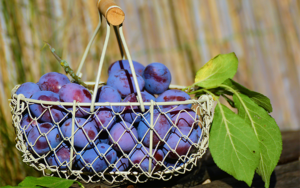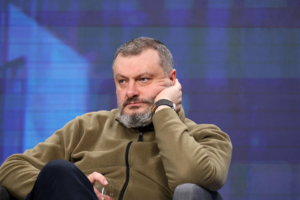
The Experts Club Information and Analytical Center conducted a study on plum cultivation (production) worldwide. A video analysis of the study is available on YouTube.
According to the results of 2023, Ukraine ranked 13th in the world in terms of plum production, according to a video graphic based on official data from the FAO (Food and Agriculture Organization of the United Nations).
The video review published by Experts Club shows the dynamics of plum production in 1991–2023 by country. According to statistics, the leading positions are held by:
TOP 5 plum producing countries in 2023:
China — the undisputed leader, with almost 7 million tons,
Romania
Chile
Serbia
Turkey
The best indicator for Ukraine in recent years was 2021, when the country ranked 9th among the world’s top plum producers. In 2023, the plum harvest in Ukraine amounted to more than 160,000 tons. The main regions for plum production are Zakarpattia, Vinnytsia, Lviv, and Chernivtsi regions.
Plums are used both fresh and for processing: dried plums, jams, juices, and pastila.
Despite military risks and the occupation of part of its southern territories, Ukraine retains its status as an important producer of stone fruits in Eastern Europe.
Global data on the production of major crops for 2024 is currently being processed and will be available within a month.
For more details, see the video review at the link.
Experts Club is a platform for analytical video discussions, interviews, and reviews on key issues in economics, politics, medicine, security, and international relations. The project brings together leading experts, scientists, businesspeople, and public figures for in-depth analysis of current events.
The channel regularly features:
interviews with relevant specialists (economists, doctors, lawyers, diplomats),
expert panel discussions,
analytical videos and infographics (including those based on data from the UN, IMF, and FAO),
reviews of the global and Ukrainian economies.
The goal of the project is to form an independent expert community and develop a culture of analytics in Ukraine.
The Experts Club YouTube channel is available at: youtube.com/@ExpertsClub

A new interview has been published on the Experts Club YouTube channel with leading Ukrainian obstetrician-gynecologist, Doctor of Medical Sciences Volodymyr Terekhov, focusing on key challenges and trends in modern gynecology. The physician, with over 15 years of experience, shares his observations on women’s health, diagnosis and treatment of gynecological diseases, as well as prospects for the development of the field in Ukraine and worldwide.
Main topics discussed
• Late diagnosis issues: According to Terekhov, up to 70% of patients seek medical help only at advanced stages of illness, including cancer, inflammatory, and hormonal disorders.
• Reproductive health: Special attention is given to declining fertility among young women, a growing trend linked to lifestyle, stress, and hormonal imbalances.
• Role of prevention: The guest emphasizes that regular check-ups and screenings (such as cytology and ultrasound) are effective early detection tools for diseases like cervical and ovarian cancer.
• Technological advancement: The conversation also covers progress in minimally invasive surgery, laparoscopy, and new diagnostic methods.
In Ukraine, according to the Ministry of Health and international NGOs, one in three women of reproductive age faces a gynecological condition — from fibroids to endometriosis. Around 4,500 cases of cervical cancer are diagnosed annually, making it one of the most common cancers among women in the country.
Globally, according to WHO, gynecological conditions affect every second woman over 30. Cervical cancer claims more than 300,000 lives annually despite the availability of vaccination and screening. Endometriosis affects up to 10% of women of reproductive age, and infertility affects one in seven couples.
Dr. Volodymyr Terekhov notes that the future of gynecology lies in the integration of new technologies, a multidisciplinary approach, patient education, and digitalization of healthcare. However, this requires investment, reforms, and state support.
Watch the full interview on the Experts Club YouTube channel:
https://www.youtube.com/watch?v=dOh20BZmI9g
Subscribe here:
https://www.youtube.com/@ExpertsClub

South African businessman Errol Musk, father of billionaire Elon Musk, made an exploratory visit to Bosnia and Herzegovina and Serbia, assessing the region’s potential for establishing an Institute for Gravitational and Space-Time Research, which would focus on gravity, space-time, terraforming, and longevity, Reuters reports.
Musk had previously considered Dubai as a potential location but abandoned the idea after friends from the Balkans persuaded him to personally evaluate the potential of Serbia and Bosnia.
He stated that he was pleasantly surprised by the level of infrastructure, business environment, and accessibility, noting: “the economy, the behavior of people… it’s idyllic.”
Representatives of the Chamber of Commerce of the Federation of Bosnia and Herzegovina presented him with an educated workforce and economic potential and offered facilities for the future institute.
Errol Musk visited Serbia and Austria as part of a preliminary regional assessment and expressed confidence that the Balkans represent a more economical and efficient solution than Dubai.
Musk envisions the institute as a privately-run platform, independent of governments, attracting professionals “not under ideological pressure” and interested in radical scientific research. The proposed research areas include gravity, space-time, nuclear fusion, and longevity — topics that go beyond conventional academic science.
Although no final decision has been made, Bosnia and Serbia are being considered by Errol Musk as more cost-effective locations with better human resources than the alternatives.

In the Serbian capital of Belgrade, police detained two men and confiscated about 20 kg of cocaine — the largest such shipment ever seized in the city.
According to Interior Minister Ivica Dačić, following a joint operation by the Criminal Police Directorate of the Ministry of Internal Affairs and the Belgrade High Prosecutor’s Office, the arrest took place during the transfer of the drugs. The convicted men are M.N. (41) and S.J. (24). They have been charged with “illegal production and trafficking of narcotic drugs.” The detainees will remain in custody until the case is brought to court.
According to EMCDDA and UNODC data, cocaine retails in Western and Central European countries for an average of €40-60 per gram, depending on purity and region. In some countries, the price can reach €100-120 per gram.
If sold at retail, the confiscated shipment could have been worth up to €1,200,000.

In June 2025, Ukrainian citizens ranked second among foreign nationals in terms of the number of properties purchased in Turkey. This is evidenced by recent data from the Turkish Statistical Institute (TÜİK). According to the published information, Ukrainians purchased 111 properties, second only to Russians, who traditionally remain the main foreign investors in the Turkish housing market, with 326 transactions per month.
Iranian citizens came in third place (109), followed by Iraq (97), Germany (95), Azerbaijan (71), Kazakhstan (66), China (54), the United States (41), and Palestine (40).
Experts attribute the growing interest in Turkish real estate to the following factors:
Visa-free travel and well-developed air links between Ukraine and Turkey;
Relatively low entry threshold: housing prices in Antalya, Alanya, and Mersin remain attractive compared to the European market;

The possibility of using housing as a means of preserving capital and as an evacuation address in the context of the ongoing war.
In addition, in June, Turkey saw an influx of buyers from Ukraine due to the active tourist season and investors seeking rental income in foreign currency.
Despite an overall decline in real estate purchases by Russians compared to the peak values of 2022–2023, Russians once again became the largest foreign buyers in Turkey in June 2025. This confirms the continuing trend of relocation, including permanent or temporary residence, against the backdrop of Russia’s international isolation.
Given the current geopolitical conditions and the attractiveness of the Turkish market, Ukraine may maintain its high position in the ranking of foreign buyers of real estate in Turkey in the coming months. At the same time, interest from Central Asian and Middle Eastern countries is also expected to pick up.
Overall, Turkey remains one of the leading destinations for real estate investment among citizens of the post-Soviet space.

According to information published in the Ukrainian media, former Secretary of the National Security and Defence Council (NSDC) of Ukraine Oleksandr Litvinenko may become the next Ukrainian ambassador to Serbia. This was reported by Verkhovna Rada deputy Oleksiy Goncharenko on his Telegram channel, citing sources in the presidential administration.
It is reported that Vladimir Zelensky will soon approve Litvinenko’s appointment to the diplomatic mission in Belgrade by decree.
There has been no official confirmation from the Office of the President or the Ministry of Foreign Affairs of Ukraine yet.
Oleksandr Valeriyovych Litvinenko, born on 27 April 1972 in Kyiv, is a Ukrainian statesman and public figure.
Education: graduated from the Institute of Cryptography, Communications and Informatics of the Russian FSB Academy (1994), received academic degrees in Kyiv and London.
He began his career in the Security Service of Ukraine (1994–1998), then held positions in the National Security and Defence Council, the Security Service and the National Institute for Strategic Studies.
In 2021–2024, he headed the Foreign Intelligence Service of Ukraine.
On 26 March 2024, by presidential decree, he became Secretary of the National Security and Defence Council, holding this position until July 2025, after which he was dismissed.
Litvinenko is a Doctor of Political Science, professor, major general, and Honoured Worker of Science and Technology of Ukraine.
According to Volodymyr Zelenskyy, Litvinenko is ‘a professional with an excellent reputation,’ and he himself is a key figure in the formation of diplomatic strategies.
It is expected that after the decree is signed, the appointment will be sent to the Serbian Assembly for approval. If the candidacy is approved, Alexander Litvinenko will head the Ukrainian diplomatic mission in Belgrade.
The main task is to strengthen bilateral political and economic dialogue, strengthen Ukraine’s position in the Balkans and promote European integration.
The appointment of Oleksandr Litvinenko as Ukraine’s ambassador to Serbia reflects Kyiv’s desire to strengthen its diplomatic presence in the Balkans. His experience working in the National Security and Defence Council, the Foreign Intelligence Service, and strategic institutions makes him a strong candidate for strengthening Ukrainian-Serbian relations.